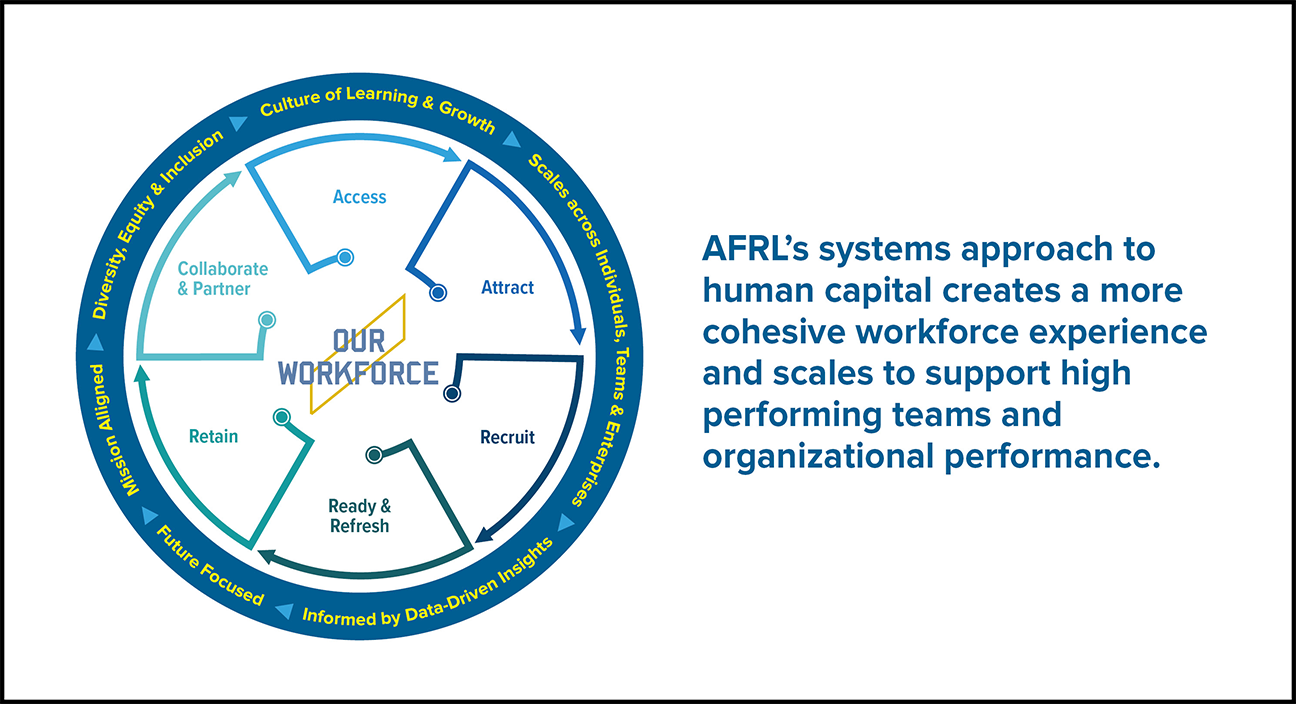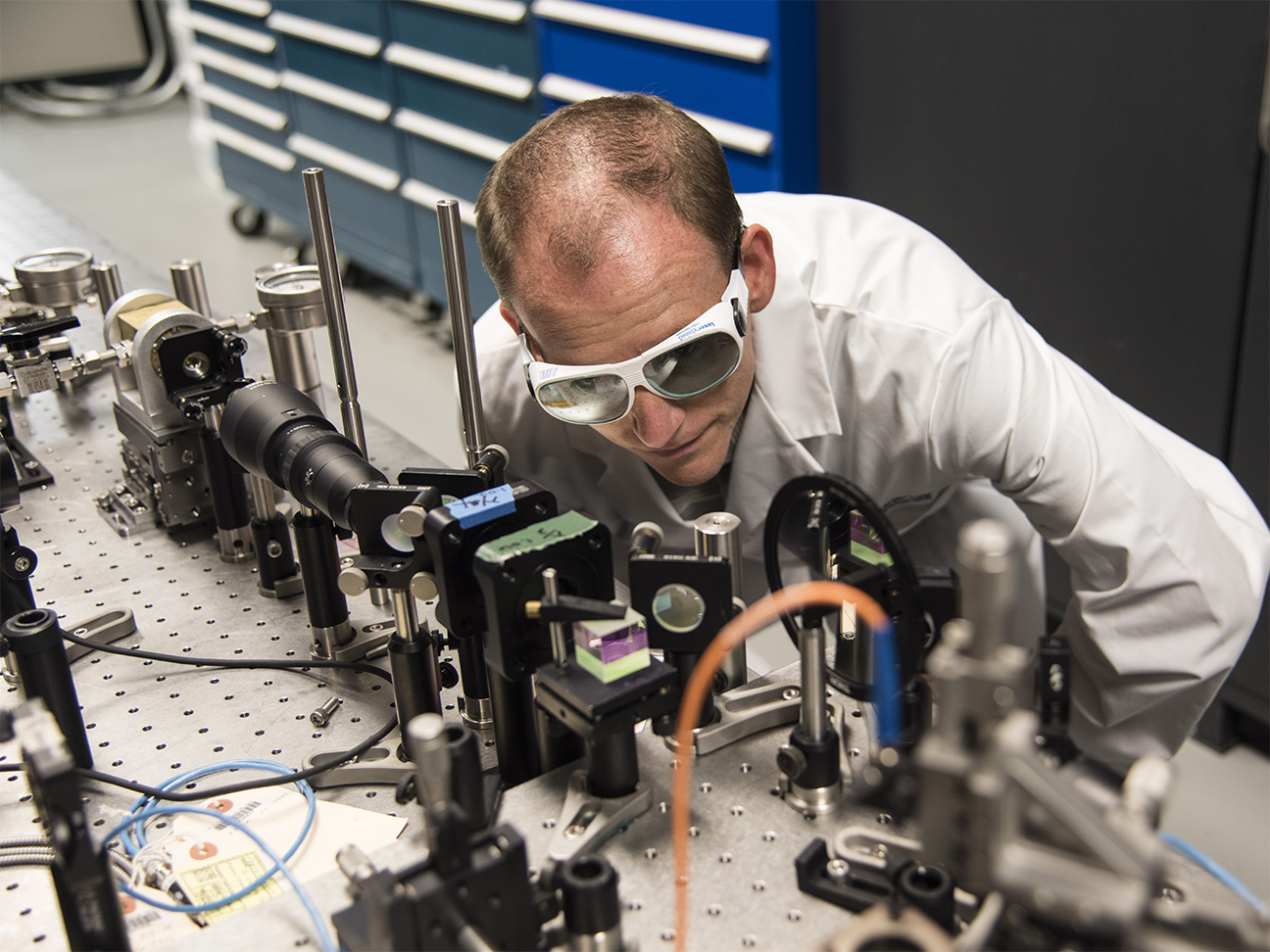AFRL continues to transform human capital management
WRIGHT-PATTERSON AIR FORCE BASE, Ohio (AFRL) — In fall 2021, the Air Force Research Laboratory, or AFRL, released its Human Capital Strategy 2021-2030 along with an action plan to achieve the strategy’s goals, embrace the future of work, address workforce expectations and posture the workforce to deliver on the mission of the Lab. In the last seven months, a team led by AFRL’s Chief Human Capital Strategist Julia Parakkat has made progress in implementing the action plan and transforming the human capital function into a strategic advantage.
“This is about bringing creativity, innovation and idea generation into taking care of our most valuable asset, our people,” Parakkat said. “This is less about launching and driving new initiatives from headquarters, but more about enabling and empowering AFRL’s directorates and mission units with the tools, insights, authorities, flexibilities and data analytics needed to make informed talent decisions that support our current and future workforce.”
The strategy is designed to empower the AFRL workforce whose mission it is to lead, discover, develop and deliver science, technology and innovation to Airmen and Guardians.
“AFRL has a talented, driven and passionate workforce in fields of critical relevance to the Department of the Air Force and the Department of Defense, including hypersonics, microelectronics, biotechnology, autonomous capabilities and artificial intelligence to name a few,” Parakkat said. “However, AFRL is not immune to the challenges of the talent environment that has been significantly shaped by the coronavirus pandemic, the rapid pace of digital changes to the nature of work and the increased competition for technical talent.”
Recent human capital actions have focused on delivering new tools, understanding the workforce’s needs, obtaining new personnel authorities, supporting AFRL’s digital transformation, strengthening outreach efforts and promoting open dialogue.
“AFRL is committed to supporting and enabling our entire workforce to be able to contribute their best,” said AFRL Executive Director Timothy Sakulich, who serves as the executive champion for human capital. “It is crucial to our mission that we have an environment where talent can converge on the hardest scientific and technical problems, innovate, and deliver solutions for Guardians and Airmen.”

AFRL is employing a new human capital lifecycle systems model to integrate AF K-12 STEM Outreach; Enterprise Internship Pipeline; Human Resources and Personnel Management; Learning and Development; Diversity, Equity, and Inclusion (DEI); and Analytics and Strategic Foresight. This approach uses data to inform AFRL on the priorities that must be addressed to support our people now and into the future through descriptive and predictive data analytics. It creates a more cohesive workforce experience and scales to support high performing teams and organizational performance. This approach embraces and institutionalizes innovation in human capital practices and policies. By assessing trends and influences on the talent market and the future of work, AFRL can prepare for the future today by continuously scanning for, applying, and pioneering leading human capital practices for the maximum benefit of all our people. (Courtesy illustration)
New tools
AFRL is partnering with the Air Force Life Cycle Management Center to advance human capital data analytics, reporting and accessibility. The two organizations are defining and prioritizing user requirements for a revamped personnel data platform. Later this year, AFRL will roll out an AFLCMC-designed tool that supports decision making and enables informed discussions around talent planning. The goal is to empower human resource professionals to track metrics and continuously improve processes such as expedited personnel actions and hiring timelines.
AFRL is also creating an overarching internship portal to streamline the application process.
AFRL’s Enterprise Internship Coordinator Dr. Oscar Martinez said a one-stop shop for all internship activities will make it easier for students to access opportunities, helping AFRL remain competitive with other programs.
The design phase is complete and AFRL’s goal is to launch the online portal by late summer, right in time for the summer 2023 cycle.
“Connecting new workforce members to the mission of AFRL is important, and we can begin that acculturation process early with our intern pipeline through this portal,” Parakkat said.
New authorities
AFRL is also pursuing a new authority to offer time off as a recruitment incentive. When used, this would afford new employees an initial leave balance to use during their first year.
“We are committed to continuously identifying mechanisms for enhancing our ability to recruit and retain top talent,” Parakkat said. “This new recruitment incentive would enable AFRL to compete with industry where upfront time off is often part of the recruitment package.”
The idea for this incentive came from an internal focus group.
“AFRL’s Personnel Directorate is taking the valuable feedback from these focus groups and developing new training initiatives and revamping current practices to better meet the needs of our workforce,” Parakkat said. “We are dedicated to continuously scanning for best practices and new ideas as we pursue innovative ways of doing business.”
Digital transformation
Another early priority outlined in the strategy focuses on supporting the workforce through AFRL’s digital transformation. To meet these multidimensional demands, AFRL’s human capital team stood up a tiger team of diverse experts to support change management, cultural barriers, talent acquisition and competency development needed for digital transformation.
Parakkat explained the need to build and develop technical depth, continuous learning and appreciation across the workforce for areas such as modeling, simulation and analysis, cybersecurity, information technology infrastructure and collaborative digital tools.
“We’ve been working hand-in-hand with AFRL’s digital transformation team to understand and assess the priority human capital needs in this area,” she said.
Outreach and engagement efforts
Another area of engagement, led by Elyse Lohrbach, the director of the Department of the Air Force’s K-12 science, technology, engineering and math, or STEM, is creating a more unified and strategic approach to STEM outreach efforts across the U.S. Air Force and U.S. Space Force. Lohrbach, who works closely with 55 coordinators or base leads at 39 active bases, provides resources and guidance for STEM awareness, engagement and exposure campaigns. She came to AFRL from the nonprofit world with deep expertise in education and outreach to the K-12 community.
“I see my job as uniting all of these efforts under one umbrella where we’ve got a 30,000-foot view of what it is were trying to accomplish with K-12 outreach,” Lohrbach said. “That way, we get everybody onboard, and we can be more consistent with our approach.”
Prior to Lohrbach’s leadership, site leads created programs with limited resources and guidance from an enterprise-level facilitator.
“What we have now is a strong framework that complements what the local base can do in terms of engaging with the community, but also keeps an eye to the national goals of the overall K-12 program,” Parakkat said.
“We are keenly aware that to create AFRL’s future workforce, we have to start right here in the present by providing students quality STEM education experiences,” Lohrbach said. “We are planting seeds for the future.”
In addition to strengthening STEM outreach, the strategy has enabled internal dialogues about critical workforce issues. Earlier this year, AFRL created a new role and hired Dr. Marcus J. Smith as the chief diversity, equity, inclusion and accessibility, or DEIA, officer. In this position, Smith serves as an adviser to AFRL senior leadership.
In 2021, AFRL stood up a DEIA council to provide a sounding board on enterprise DEIA dealings, from development of a strategic plan to roll out of various initiatives, which aims to ensure all individuals have equal access to opportunities and can maximize the potential of their skills, talents and expertise. With representation from across the enterprise, the council is the eyes and ears of the organization.
“Not only are they amplifiers of the AFRL DEIA voice, but they can see what’s going on at the ground level and report back so we can make modifications as needed to goals, objectives and initiatives,” Smith said.
Smith, who previously served as the diversity and inclusion lead for AFRL’s Aerospace Systems Directorate, is excited for his role providing a holistic, enterprise approach to DEIA.
“Getting DEIA embedded in the human capital strategy was a really good first start, but it is a living strategy, so we need to be constantly reassessing and expanding upon this to ensure that we are building something sustainable for years to come,” Smith added.
Flexible plans
While the framework for executing the strategy is in place, Parakkat said, as AFRL’s mission priorities change, the human capital approach must also evolve. Accordingly, AFRL plans to release an annual action plan each fiscal year.
“It’s important that we continue to engage and discuss at all levels,” Parakkat said. “AFRL’s Human Capital Strategy is purposefully designed to be a living strategy to flexibly incorporate and address the dynamic environment.”
AFRL launched an internal virtual human capital community of practice channel, which is open to the entire workforce. The goal is to share workforce-related best practices and ideas.
Further information on AFRL’s Human Capital Strategy will be shared via internal AFRL communication channels including Teams. To view the strategy, CLICK HERE.

Dr. Christian Keyser at the AFRL Munitions Directorate examines laboratory equipment designed to study the way that weapon seeker optics detect light. (Courtesy photo)

Air Force Research Laboratory scientists, Dr. Nicholas Shuman and Jenny Sanchez, conduct an experiment in the Space Vehicles Directorate’s plasma chemistry lab used to understand how the space environment affects spacecraft in orbit. (Courtesy photo)

The Air Force Research Laboratory’s “Digital Transformation” adopts IT solutions to enable its scientists, engineers and subject matter experts more instant and efficient collaboration, across AFRL’s 40 worldwide operational locations, for faster development and deployment of technologies that help the warfighter maintain the technological advantage over U.S. adversaries. (U.S. Air Force graphic/Randy Palmer)
